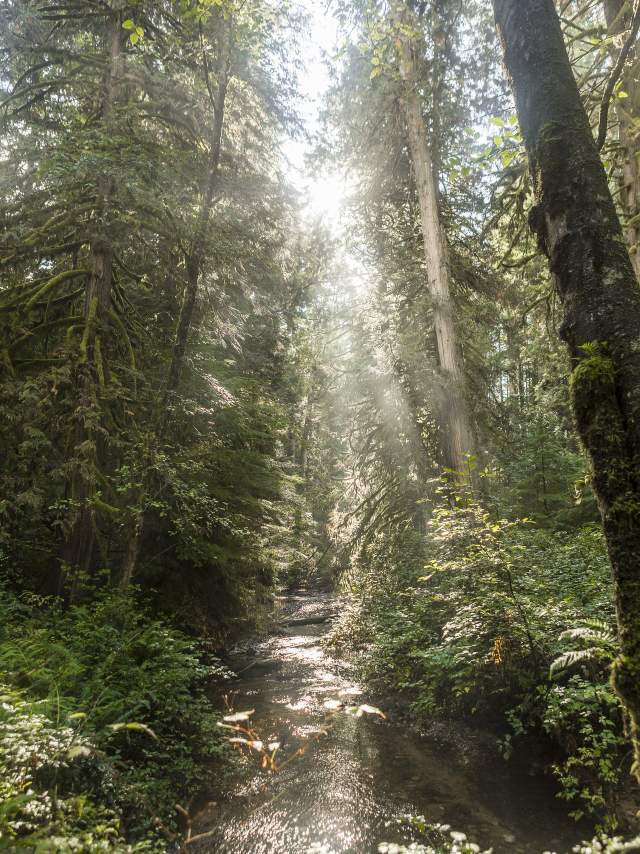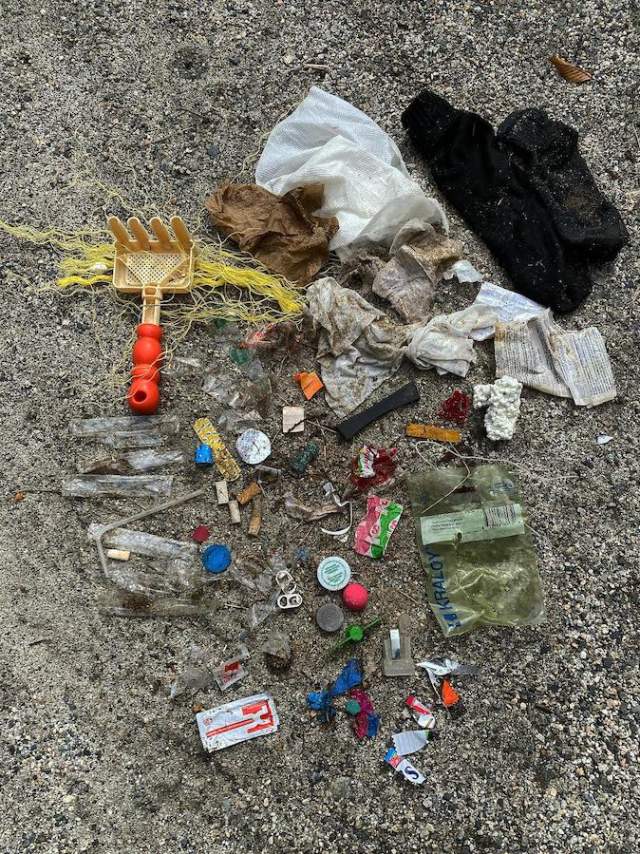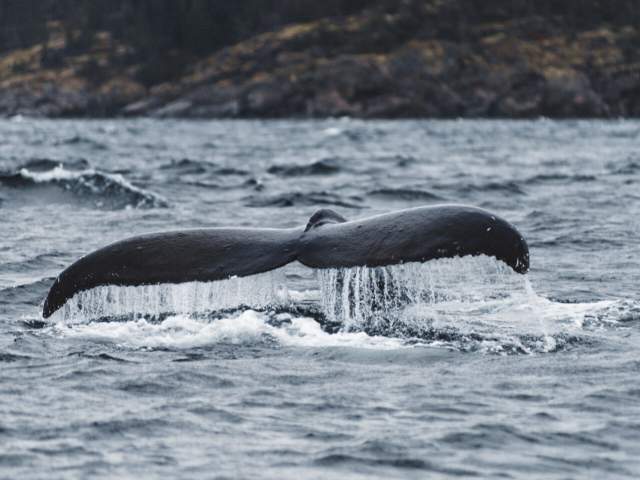It's no wonder people are drawn to the Sunshine Coast: it has close access to Vancouver and Vancouver Island, miles of stunning beaches, chilled-out coastal communities, towering mountain peaks, and spectacular scenery at every turn. And while we welcome visitors to play and stay on the coast, the demands on our destination have increased, making it more important than ever to be a mindful visitor.
Being a mindful visitor requires a thoughtful approach to travel, one that will ensure the sustainability of our resources, places, and spaces—both for the people who visit and those who live here, including the Tla’amin, Klahoose, shíshálh, and Skwxwú7mesh nations who have called this place home since time immemorial.
We've put together a few tips for being a mindful visitor—read on for details.
Leave No Trace
The tenets of Leave No Trace are intended to keep our natural spaces wild, but they work as thoughtful reminders in our everyday lives, too. At the core of Leave No Trace is considering how your actions impact others and the spaces around you. Before venturing outside, whether it's in the frontcountry, along a main street in a downtown community, or in the backcountry, take heed of these seven guiding principles:
- Plan ahead and be prepared
- Travel and camp on durable surfaces
- Dispose of waste properly
- Leave it better than you found it
- Keep campfires responsible
- Keep wildlife wild
- Be considerate of others
By minimizing our impact, we can help preserve and protect the natural beauty of the Sunshine Coast for generations to come.
Conserve Water
On the Sunshine Coast, everyone from our visitors to our wildlife relies on fresh water. Water conservation is a shared effort, one that we must all participate in. By minimizing our water use and being respectful and mindful of restrictions and supplies, we ensure access to water for all. Find out more about water conservation efforts.

Choose Green(er) Transportation Choices
The Sunshine Coast is connected via a single main highway thoroughfare, and during popular travel times, it can get busy. But travelling by car is not the only way to see the Sunshine Coast. With miles of stunning coastline, a boat or sailing trip will grant you a different perspective, while increased cycling infrastructure coupled with bike-friendly accommodations, breweries, and restaurants means a two-wheeled trip to the Coast is not only possible, but enjoyable. Local bus transportation and car sharing services like Coastal Rides offer vehicle access when needed but without the expense of driving your car. Greener transportation choices offer a more environmentally-friendly way to travel on the Sunshine Coast, with some other perks: no ferry reservations or line-ups!
Social Media Etiquette
Social media offers us unprecedented access to some of the world’s most beautiful destinations, all from the devices in our pockets. But with this access comes a cost. The increased pressure on specific “Instagrammable” locations has led to crowding, erosion, overtourism, and other problems.
When travelling on the Sunshine Coast, consider leaving the names and locations of specific sensitive areas private. If asked, you may wish to respond in a private message rather than posting on a publicly-accessible social profile, or encourage others to explore without the aid of social media (the discovery is half the fun!). Most locations can be found with very little effort by those who truly want to find them.
Likewise, consider avoiding ultra-popular destinations, parks, beaches, and other natural spaces that are prone to this pressure. There are many wonderful, interesting, and under-explored places on the Sunshine Coast that both welcome and can accommodate visitors.
Be AdventureSmart
From paddling in Howe Sound and the Sechelt Inlet to rock climbing the imposing Eldred Valley in Powell River, experiencing the Sunshine Coast’s great outdoors is a must. While it’s easy to throw yourself into the next great adventure, keep in mind that every time you head outdoors comes with a risk.
If you are ill-prepared or exceed your ability, you risk seriously injuring yourself and others. Not to mention, local search and rescue teams are primarily volunteer-based and, while they offer assistance in these instances, each call puts them at risk and strains a destination’s resources and infrastructure.
Incorporating AdventureSmart’s Three Ts (Trip Planning, Training, and Taking the Essentials) before you head outdoors reduces your risk of injury and the number of calls to our local SAR teams.
Make a Connection
Travel is one of the great joys and pleasures in life. But it’s important to remember that one person’s dream destination is another person’s home. And here on the Sunshine Coast, we’re all visitors on the traditional and unceded territories of the Tla’amin, Klahoose, shíshálh, and Skwxwú7mesh nations.
Practice mindful travel by learning about the Sunshine Coast’s culture and history, talking to locals, learning Indigenous place names, and taking a moment to enjoy our natural surroundings. Fostering connections will help you gain appreciation for the coast, and give you insight into why protecting this place is so important to us.
Engage in Ocean-Friendly Travel
There is no Sunshine Coast without our coast. Our access to water is part of what makes our destination so incredible, and it offers much inspiration for our visitors and residents.
Practicing ocean-friendly travel means that you are committing to keeping our water and beaches clean. Every small action you take adds to a larger one, and by practicing some of the following tips you can help contribute to a clean and healthy coastal ecosystem:
- Avoid single-use plastic, such as straws and water bottles
- Bring your own utensils, water bottle, and plastic-free cutlery
- Pack reusable shopping and produce bags
- Bring your own reusable (and ideally natural) toiletry supplies
- Pack out any beach garbage that you see, even if it’s not yours
- Avoid wearing synthetic clothing that contributes to microfibre pollution

Shoulder Season Travel
Summer is an especially busy season for the Sunshine Coast. Consider travelling to less-frequented areas of the coast or choose to travel during non-peak times and seasons, like fall and winter. With some foresight and planning, you can plan ahead and enjoy the Sunshine Coast as you intend.
Practice Responsible Wildlife Viewing
Witnessing wildlife in its natural habitat is a privilege to behold. For many, the allure of a destination rests on its incredible wildlife viewing opportunities. On the Sunshine Coast, we share our backyard with many different species, from the black bears that roam our woods and the owls in our trees to the whales and seals that play in our waters.
Responsible wildlife viewing boils down to ensuring your actions—as an individual, a group, and that of the tour operator—do not cause an animal to change their normal behaviour. Keeping wildlife wild helps to maintain the natural and precious balance of the ecosystem.
Other aspects of responsible wildlife viewing include maintaining a safe distance (both on the water and on land), reducing noise, limiting viewing time, and minimizing conflict with animals by being prepared, smart, and respectful of sensitive habitat and areas.

Be Respectful
This one’s simple: treat others (and spaces) as you wish to be treated. Responsible tourism means that the experience creates a positive impact for everyone involved—both residents and visitors alike.
Thank you for being a mindful visitor to the Sunshine Coast!
